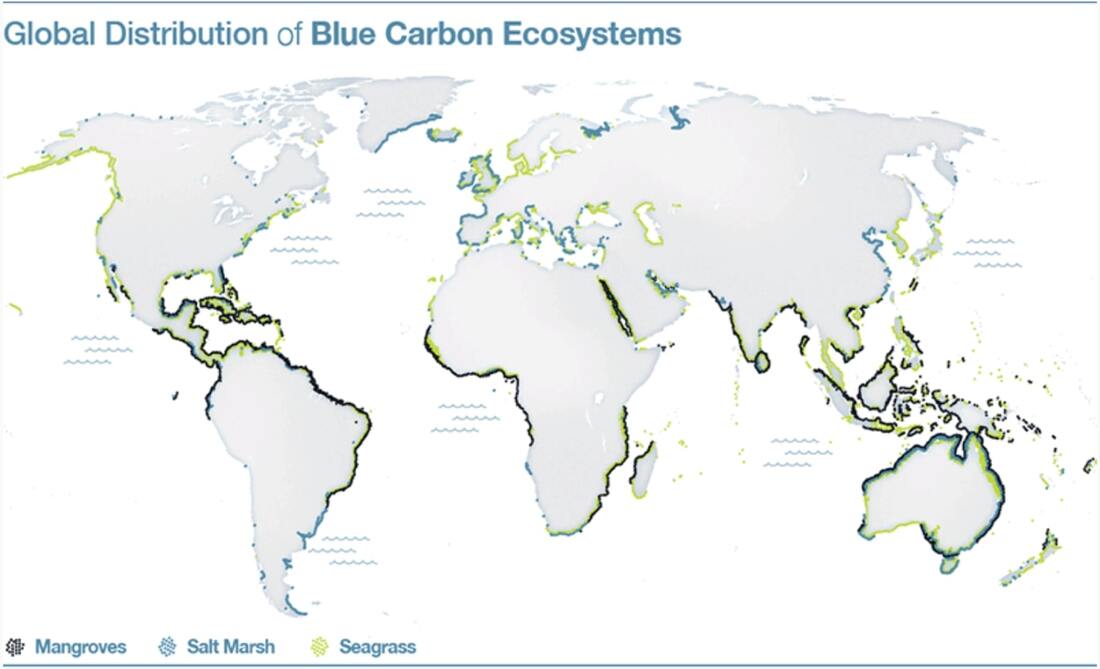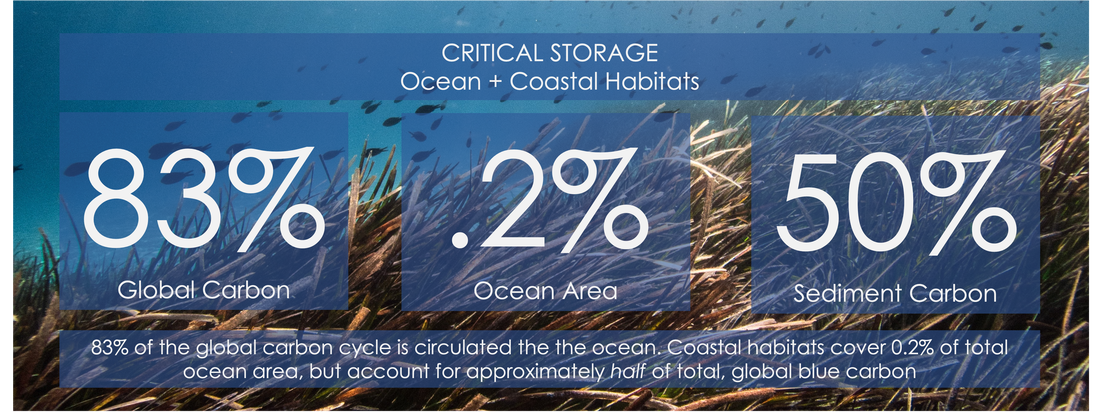What is Blue Carbon?
 Blue Carbon Initiative, Data from Giri et al., 2011; Mcowen et al., 2017; Centre, 2016. Blue Carbon Initiative, Data from Giri et al., 2011; Mcowen et al., 2017; Centre, 2016.
Carbon sequestration is the process of capturing atmospheric carbon dioxide (CO2) and storing it away from the atmosphere, essentially removing it from the carbon cycle and preventing it from contributing to the greenhouse effect and, by extension, climate change. This processes happens naturally in many ecosystems and has been identified as an important component in our fight against climate change. Since the ocean mediates over 80% of carbon in the global carbon cycle, marine ecosystems are a critical component of global carbon sequestration. The carbon permanently stored in marine systems has been dubbed “blue carbon.”
The typical example of carbon sequestration is a forest ecosystem using photosynthesis to convert CO2 to oxygen and plant biomass, as the trees grow, more and more carbon is removed from the atmosphere and stored both within the trees themselves and within the soil. But - coastal marine ecosystems have gained particular attention in the fight against climate change as several (mangroves and salt marshes, particularly) sequester and store more carbon (blue carbon) per unit area than any terrestrial ecosystem. Also, unlike many terrestrial systems, a larger proportion of the blue carbon stored in these ecosystems is in soil/sediment carbon than in living plant biomass, theoretically keeping it out of the atmosphere for longer. For example, over 95% of the blue carbon stored in seagrass meadows is stored in the sediment. The impact of these coastal marine ecosystems on blue carbon is so pronounced that, though coastal systems make up only 0.2% of ocean area, they are thought to account for half of all oceanic sediment carbon storage. However, the three ecosystems that store the most blue carbon per unit area (mangroves, salt marshes, and seagrass meadows) are also some of the most threatened natural systems on earth. When these systems are destroyed or degraded, they cannot function optimally and cannot store as much carbon as in their pristine states. It is currently estimated that degraded coastal ecosystems actually release CO2 at a rate equivalent to ~20% of emissions from tropical deforestation annually. Therefore, understanding our impact on the carbon storage in these systems is key to closing the global carbon budget. Further conserving and restoring these ecosystems could provide substantial benefits in the fight against climate change. Additionally, there is still a lot we don’t know about coastal blue carbon. Because coastal ecosystems are incredibly dynamic and variable systems, our ability to quantify coastal carbon emission and sequestration is limited. For example, carbon dynamics in the coastal zone can be influenced by upstream processes like river discharge, and downstream, oceanic processes simultaneously, and can rapidly change due to human activities at the local (e.g. land use change or pollution) and regional/global scales (e.g. increasing water temperature and sea level rise). All of these drivers can have profound impacts on carbon cycling in coastal systems. Certain ecosystems are also better studied than others, for example, we know more about blue carbon in mangroves and salt marshes than we do in intertidal sediments and aquaculture systems. Therefore, more affordable and widely deployable means of measuring coastal blue carbon, like those developed by this program, will be critical for gathering the data necessary to understand how these important ecosystems can help mitigate climate change. |
Summary |
